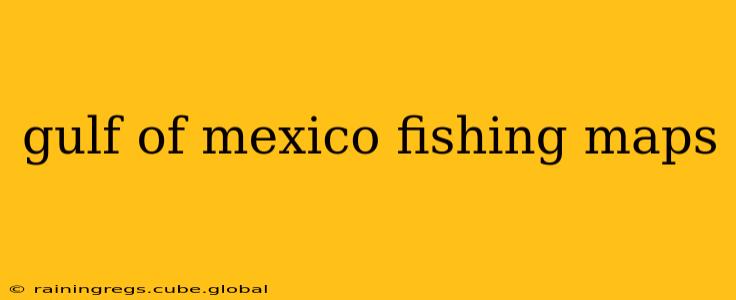The Gulf of Mexico, a vast and diverse body of water, is a renowned fishing paradise. From inshore flats teeming with speckled trout to offshore reefs brimming with red snapper, the opportunities are seemingly endless. However, navigating this expansive area requires knowledge and the right tools. This guide will explore the world of Gulf of Mexico fishing maps, helping you find the best spots for your next fishing adventure.
What Makes a Good Gulf of Mexico Fishing Map?
Before diving into specific map options, let's discuss the essential features of a high-quality fishing map. A truly effective map goes beyond simple navigational charts; it integrates crucial information for successful fishing trips. Key features include:
- Detailed bathymetry: This is arguably the most critical element. Knowing the water depth, contours, and underwater structures (like reefs, wrecks, and ledges) is paramount for locating fish. Look for maps with high-resolution depth readings.
- Clear labeling of navigational hazards: This includes buoys, markers, shoals, and other obstacles that could affect your boat's safe passage.
- Identification of key fishing spots: Many maps pinpoint popular fishing areas, often categorized by species.
- Integration of GPS coordinates: This allows for precise navigation and easy marking of your favorite fishing spots.
- Species-specific information: Some maps provide information on the types of fish commonly found in specific areas. This helps target your fishing efforts effectively.
- Up-to-date information: Ensure the map is current, as water conditions and fishing regulations can change.
Different Types of Gulf of Mexico Fishing Maps
Several types of maps cater to different fishing styles and preferences:
- Paper Charts: Traditional nautical charts provide a solid foundation, especially for experienced anglers who appreciate the tactile experience and offline accessibility. However, they lack the dynamic features of digital maps.
- Digital Charts (on Chartplotters): These are integrated into fish finders and chartplotters, offering real-time GPS data, sonar integration, and the ability to mark waypoints. They are generally more expensive but provide unmatched convenience and functionality.
- Online Fishing Maps: Numerous websites and applications offer detailed fishing maps, often with community-contributed data on hot spots and fishing reports. These are often affordable or free, offering a balance between cost and functionality.
- Specialized Fishing Apps: Apps like Navionics, Fishidy, and others integrate mapping with social features, allowing anglers to share information and discover new fishing locations.
Where Can I Find Free Gulf of Mexico Fishing Maps?
While many detailed maps require a purchase, several sources offer free options, although the level of detail might be limited:
- NOAA Charts: The National Oceanic and Atmospheric Administration (NOAA) provides free nautical charts, though they might not include specific fishing information. These are excellent for navigation and understanding water depths.
- Online Map Aggregators: Some online map services may offer basic fishing map functionality as part of a larger suite of tools. However, the detail and features might be less extensive than specialized fishing apps.
What are the best paid Gulf of Mexico Fishing Maps?
The best paid maps provide comprehensive data, often incorporating features like:
- High-resolution bathymetry: Allows for the identification of even subtle changes in water depth.
- Detailed navigational charts: Ensures safe navigation.
- Community-contributed data: Provides insights from fellow anglers.
- Integration with other marine apps: Seamless connection with other fishing tools.
Specific recommendations for paid maps would require research on current offerings. Reading reviews on sites like Amazon or specialized fishing forums will provide valuable insights.
How Do I Use a Gulf of Mexico Fishing Map Effectively?
Using your chosen map effectively involves a multi-step process:
- Planning your trip: Identify your target species, and choose a fishing area known for those species.
- Study the map: Familiarize yourself with the bathymetry, navigational hazards, and marked fishing spots.
- Identify potential fishing locations: Look for areas with the right water depth, structure, and proximity to known fish habitats.
- Mark waypoints: Use your GPS to save the coordinates of promising spots.
- Utilize sonar: Combine your map with sonar technology to confirm the presence of fish and underwater structures.
- Check weather conditions: Always check the forecast before heading out.
What are some popular fishing spots in the Gulf of Mexico?
The Gulf of Mexico offers a vast array of fishing locations, each with its own unique characteristics. Popular areas include:
- Florida Keys: Known for backcountry flats fishing, targeting bonefish, tarpon, and permit.
- Texas Coast: Offers diverse inshore and offshore fishing opportunities, from redfish and speckled trout to snapper and grouper.
- Louisiana marshes: Famous for its abundant redfish, speckled trout, and other inshore species.
- Mississippi Sound: Provides a variety of habitats, supporting a diverse fish population.
By utilizing the appropriate Gulf of Mexico fishing maps and combining them with sound fishing practices, you can greatly increase your chances of a successful and safe fishing trip. Remember to always prioritize safety and adhere to all fishing regulations. Happy fishing!
